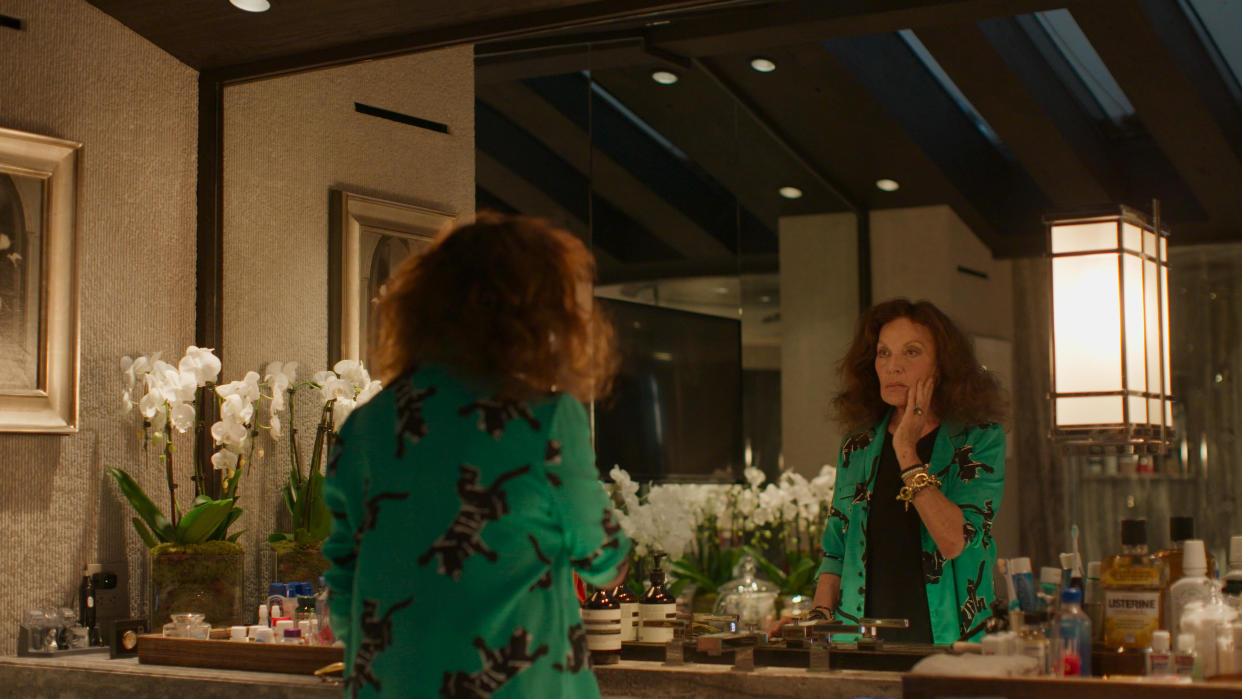‘Diane von Furstenberg: Woman in Charge’ Review: The Fashion Icon Gets Wrapped Up in a Blandly Reassuring Portrait

An ever-upholding vanity project portrait of a dyed-in-the-annals sartorial icon, “Diane von Furstenberg: Woman in Charge” is an engaging enough documentary for the small screen but not big enough to merit anything more. That’s appropriate, as the movie heads to Hulu two and a half weeks after its Tribeca Festival premiere in a New York theater. Directors Sharmeen Obaid-Chinoy and Trish Dalton’s film is a hagiographic survey of the life and career of the Jewish girl born in Belgium who married into German royalty, became a princess, and started a fashion empire that included the invention of the now-ubiquitous wrap dress. With talking heads including Hillary Clinton and Oprah Winfrey, the documentary emerges more as agitprop for feminist galvanizing in the months up toward an election in which women’s rights are on the slab.
Though certainly spikier and with a zero-fucks-given, indecorous lack of platitudes is talking head Fran Lebowitz, proud New Yorker and sardonic lesbian and actual good friend of Furstenberg’s. And Furstenberg’s wealthy friends are many, and former and almost lovers even more. The documentary moves linearly through Furstenberg’s life, stopping and starting along the way with the sexist lines of questioning she received on late night and daytime TV, from even David Letterman to Regis Philbin, observing that an older Furstenberg looks different than her younger self.
More from IndieWire
Furstenberg, with her frizzy, blown-out hair and color-popped frocks — ones which briefly fade away into Susan Sontag-esque shoulder pads and dark pleated pants during a brief love affair with a controlling Parisian writer — was a sight to see. And she did stand as an emblem of feminism, of chafing against the seams especially in the ‘70s when women were asked to androgenize their looks to get out of the kitchen and ahead in the workplace. But then there was Furstenberg, whose career began under the tutelage of Vogue fashion editor Diana Freeland, championing femininity, and silhouettes, pastels, and prints.
“Woman in Charge” argues that Furstenberg’s lodestar always was a kind of feminist pursuit, even as the documentary contorts her life story to retroactively imbue it with more of a feminist narrative than it perhaps consciously had: Was going on QVC, where then fashionistas dared not go, and selling the 2023 equivalent to $2.6 million in two hours in 1992 a sleight of feminism, or the product of capitalism? Just because you’ve got Clinton’s endorsement doesn’t mean it’s the former. But maybe, for a Jewish immigrant fashion designer who fled a gay German husband for the American dream, it could be both.
And “Woman in Charge” is most piquant when it’s dishing on the many loves of Diane von Furstenberg. “I’m 76 going on 300,” Furstenberg says at one point, and 300 is also probably the number of lovers, men and women, she’s had over her three-quarters of a century alive. Her son, Prince Alexander von Fürstenberg, in one on-camera interview, mentions the existence of a “list,” presumably a list of all the celebrities she’s bedded. There was Ryan O’Neal and Warren Beatty on the same day (making Furstenberg’s conquest almost the inverse of that epic true yarn of when Carly Simon’s therapist told the singer that she was not the first patient that day to say she’d slept with Warren Beatty … that day). Then there was Mick Jagger and David Bowie who together propositioned Furstenberg for a threesome, who turned them down. She was not afraid of her desires, which meant not being afraid of also dialing them down.
Which was rare. During the off-and-on years with Diller before they eventually married in 2001, she once left him for that Parisian writer but also for a beach bum in Bali. Her first great love was Prince Egon von Fürstenberg, who turned out to be gay but stayed close with Diane and their two children up through his death of AIDS complications in 2004. “Woman in Charge” weaves a familiar thread from the overwhelmingly, openly flowing carnal energy exploding out of Studio 54 to the sexual death knell of AIDS hitting in the very early 1980s. Anyone who’s seen documentaries about pop culture spanning the ‘60s through the ‘80s — and especially as far as sex is concerned — has seen this very montage, from Quaalude-fueled excess to lesions, hospital beds, and the end of the sexual revolution. “Woman in Charge” offers no new insights about where women and feminism fit into that framework, though the gay men Furstenberg loved were all affected by it.
Most compellingly, “Woman in Charge” reveals the crisis of consciousness Furstenberg had around coming to terms with her mother being a survivor of Auschwitz. Furstenberg didn’t think about it until late into life — and her response was to take her kids to Bali and roll around in the sand with the beautiful Brazilian beach boy. A less fawning documentary portrait would scrutinize this episode, one notch on a life’s bedpost, with a cannier, more playful eye. Hints of a more macabre inquiry are there, too, in Diane von Furstenberg’s own addresses to the filmmakers, revealing how she thinks about death every day. And always has her entire life.
But “Woman in Charge” is a you-go-girl, grab-your-sexuality-by-the-bodice portrait of, well, a woman in charge, not a creative fashion documentary in the vein of “McQueen” or “The September Issue,” which found ways to capture the spirit of their subjects through their formal style. This Diane Von Furstenberg is plenty engaging, but as a tribute to the woman who reinvented the modern dress, it doesn’t reinvent anything itself.
Grade: C+
“Diane von Furstenberg: Woman in Charge” opened the 2024 Tribeca Festival. The film premieres on Hulu on Friday, July 25.
Best of IndieWire
Sign up for Indiewire's Newsletter. For the latest news, follow us on Facebook, Twitter, and Instagram.

 Yahoo News
Yahoo News 
